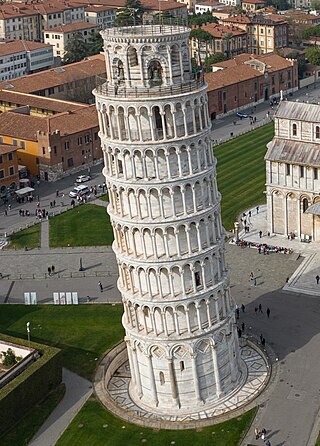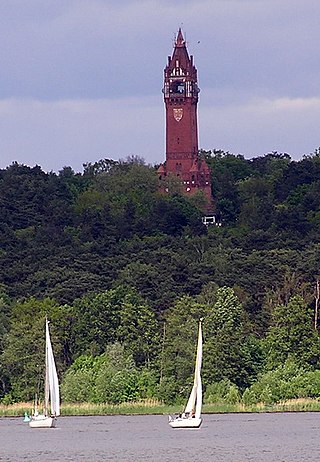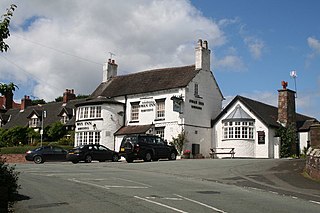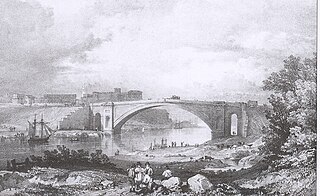
The Leaning Tower of Pisa, or simply the Tower of Pisa, is the campanile, or freestanding bell tower, of Pisa Cathedral. It is known for its nearly four-degree lean, the result of an unstable foundation. The tower is one of three structures in the Pisa's Cathedral Square, which includes the cathedral and Pisa Baptistry.

Bedum is a former municipality and a town in the northeastern Netherlands. Populated by data missing inhabitants in 2021, Bedum is one of the larger of Groningen's several satellite towns. On 1 January 2019 it merged with the municipalities of De Marne, Eemsmond and Winsum to form the new municipality Het Hogeland.

The Piazza dei Miracoli, formally known as Piazza del Duomo, is a walled 8.87-hectare (21.9-acre) compound in central Pisa, Tuscany, Italy, recognized as an important center of European medieval art and one of the finest architectural complexes in the world. It was all owned by the Catholic Church and is dominated by four great religious edifices: Pisa Cathedral, the Pisa Baptistery, the Leaning Tower of Pisa, and the Camposanto Monumentale. Partly paved and partly grassed, the Piazza dei Miracoli is also the site of the Ospedale Nuovo di Santo Spirito, which now houses the Sinopias Museum and the Cathedral Museum.

Ulm Minster is a Lutheran church located in Ulm, State of Baden-Württemberg (Germany). It is the tallest church in the world. The church is the fifth-tallest structure built before the 20th century, with a steeple measuring 161.53 metres.

The Grunewald Tower or is a historical tower in the Grunewald forest of southwestern Berlin, Germany, built in 1897-99 according to plans designed by Franz Heinrich Schwechten. The viewing platform offers a view over the Havel at a height of 36 metres (118 ft).

St. Peter's Church is a Lutheran church in Riga, the capital of Latvia, dedicated to Saint Peter. It is a parish church of the Evangelical Lutheran Church of Latvia.

Bad Frankenhausen is a spa town in the German state of Thuringia. It is located at the southern slope of the Kyffhäuser mountain range, on an artificial arm of the Wipper river, a tributary of the Unstrut. Because of the nearby Kyffhäuser monument dedicated to Emperor Frederick Barbarossa, it is nicknamed Barbarossastadt. The municipality includes the villages of Seehausen, Udersleben, Esperstedt and Ichstedt and Ringleben.

Pyramidenkogel is an 851-metre-high (2,792 ft) mountain in Carinthia, Austria. It is located to the south of the Wörthersee and near the town of Maria Wörth, in an area that is a boundary between speakers of German and Slovenian. In nearby Slovenia the mountain is known as Jedvovca. The mountain has been a tourist attraction since at least the late 19th century. The view from its top is mentioned in Karl Baedeker's 1879 The Eastern Alps.

The New Town Hall is a town hall in Hanover, Germany. It opened on 20 June 1913 after construction lasting 12 years. A magnificent, castle-like building of the era of Wilhelm II in eclectic style at the southern edge of the inner city just outside the historic city centre of Hanover, the building is embedded within the 10-hectare (25-acre) Maschpark.

Suurhusen is a village north of Emden in the German region of East Frisia. It has about 1,100 inhabitants and is administered by the municipality of Hinte. The steeple of the Suurhusen church, inclined at an angle of 5.19 degrees, is the most leaning tower of the world, beating the Leaning Tower of Pisa by 1.22 degrees.

Wybunbury is a village and civil parish in the unitary authority of Cheshire East and the ceremonial county of Cheshire, England. The village lies 3¼ miles to the south east of Nantwich and 3¾ miles to the south of Crewe. The parish also includes the settlements of Clannor Heath, Daisy Hill, The Flag, Pinfold and parts of Blakelow, Haymoor Green and Howbeck Bank. Nearby villages include Hough, Shavington, Stapeley and Walgherton. The A51 runs east–west through the south-western corner of the parish.

Dausenau is a municipality in the district of Rhein-Lahn, in Rhineland-Palatinate, in western Germany. It belongs to the association community of Bad Ems-Nassau.

James Trubshaw was an English builder, architect and civil engineer. His civil engineering works include the construction of the Grosvenor Bridge in Chester, Cheshire, then the longest stone span. He also pioneered the technique of underexcavation with the straightening the leaning tower of St Chad's in Wybunbury, Cheshire.

Capital Gate, also known as the Leaning Tower of Abu Dhabi, is a skyscraper in Abu Dhabi that is over 160 meters (520 ft) tall, 35 stories high, with over 16,000 square meters (170,000 sq ft) of usable office space. Capital Gate is one of the tallest buildings in the city and was designed to incline 18° west, more than four times the lean of the Leaning Tower of Pisa. The building is owned and was developed by the Abu Dhabi National Exhibitions Company. The tower is the focal point of Capital Centre.

John Boscawen Burland is a geotechnical engineer, Emeritus Professor and Senior Research Investigator at the Department of Civil and Environmental Engineering of Imperial College London, and a noted expert in the field of soil mechanics.

The Leaning Tower of Teluk Intan is a leaning clock tower in Teluk Intan, Hilir Perak District, Perak, Malaysia. It is the Malaysian equivalent of the Leaning Tower of Pisa. It is 25 m (82 ft) and, from the outside, looks like an 8 storey building, though inside it is actually divided into 3 storeys.

The Great Mosque of al-Nuri was a mosque in Mosul, Iraq. It was famous for its leaning minaret, which gave the city its nickname "the hunchback". Tradition holds that the mosque was first built in the late 12th century, although it underwent many renovations over the years. The mosque withstood various hostile invading forces over its 850-year history until it was destroyed, along with its distinctive minaret, in the Battle of Mosul in 2017.

Miedum is a hamlet in Leeuwarden municipality in the province of Friesland, the Netherlands.

The Oberkirche, also Kirche Unserer Lieben Frauen am Berge or Bergkirche, in Bad Frankenhausen, Thuringia, Germany, is a Gothic church building. Its 56-metre-high (184 ft) leaning tower has the largest overhang of all German towers at 4.6 m (15 ft) to north-east and is a landmark of the town.

























